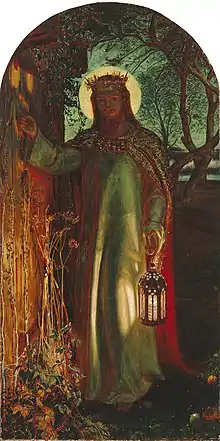The Light of the World (painting)
The Light of the World (1851–1853) is an allegorical painting by the English Pre-Raphaelite artist William Holman Hunt (1827–1910) representing the figure of Jesus preparing to knock on an overgrown and long-unopened door, illustrating Revelation 3:20: "Behold, I stand at the door and knock; if any man hear My voice, and open the door, I will come in to him, and will sup with him, and he with Me". According to Hunt: "I painted the picture with what I thought, unworthy though I was, to be divine command, and not simply a good subject."[1] The door in the painting has no handle, and can therefore be opened only from the inside, representing "the obstinately shut mind".[2] The painting was considered by many to be the most important and culturally influential rendering of Christ of its time.[3]

Versions
The original is variously said to have been painted at night in a makeshift hut at Worcester Park Farm in Surrey and in the garden of the Oxford University Press[4] while it is suggested that Hunt found the dawn light he needed outside Bethlehem on one of his visits to the Holy Land.[5] In oil on canvas, it was begun around 1849/50,[5] completed in 1853, exhibited at the Royal Academy in 1854 and is now in the side chapel at Keble College, Oxford.[6][7] The painting was donated to the college by Martha Combe, the widow of Thomas Combe, Printer to the University of Oxford, Tractarian and a patron of the Pre-Raphaelites, in the year following his death in 1872[4] on the understanding that it would hang in the chapel (constructed 1873–1876) but the building's architect William Butterfield was opposed to this and made no provision in his design. When the college's library opened in 1878 it was placed there, and was moved to its present position only after the construction in 1892–1895 by another architect, J. T. Micklethwaite, of the side chapel to accommodate it.[8]
A second, smaller version of the painting, painted by Hunt between 1851 and 1856, is on display at Manchester City Art Gallery, England, which purchased it in 1912.[9] There are small differences between this and the first version, such as the angle of the gaze and the drape of the corner of the red cloak.
The fact that Keble College at that time charged a fee to view it[4] persuaded Hunt toward the end of his life to paint a larger, life-size, version, begun about 1900 and completed in 1904, which was purchased by shipowner and social reformer Charles Booth and hung in St Paul's Cathedral, London, where it was dedicated in 1908 after a 1905–1907 world tour where the picture drew large crowds.[10] It was claimed that four-fifths of Australia's population viewed it.[11] Due to Hunt's increasing infirmity and glaucoma, he was assisted in the completion of this version by English painter Edward Robert Hughes (who also assisted with Hunt's version of The Lady of Shalott). This version diverges more from the original than the second one.
Reception
The painting gave rise to much popular devotion in the late Victorian period and inspired several musical works, including Arthur Sullivan's 1873 oratorio The Light of the World.[3] Engraved reproductions were widely hung in nurseries, schools and church buildings.[11]
References
- "William Holman Hunt Artworks". The Art Story. Archived from the original on 27 October 2020. Retrieved 8 January 2021.
- Hunt 1905, p. 350.
- Landow, George P. (December 2001). "The Light of the World". Victorian Web. Archived from the original on 14 September 2020. Retrieved 2016-09-03.
- Hibbert, Christopher, ed. (1988). The Encyclopædia of Oxford. London: Macmillan. pp. 20, 197, 208–9. ISBN 0-333-39917-X.
- "Chapel History and Treasures". Keble College. Retrieved 2016-09-03.
- Hunt 1905, pp. 299–300.
- Dalton, Nick (2012-08-21). Frommer's France and the Best of Wales. John Wiley & Sons. pp. 349–. ISBN 978-1-118-33137-8. Retrieved 2013-01-19.
- "Inside the Chapel". Keble College. Retrieved 2016-09-02.
- "The Light of the World". Art UK. Retrieved 2019-03-24.
- "The Light of the World". St Paul's Cathedral. Retrieved 2016-09-03.
- Fulford, Robert (2007-12-24). "The Light fantastic: Loved but neglected painting of Jesus became a touchstone of mass culture". National Post. Retrieved 2016-09-03.
Works cited
- Hunt, W. H. (1905). Pre-Raphaelitism and the Pre-Raphaelite Brotherhood. 1. London: Macmillan.
Further reading
- Maas, Jeremy (1984). Holman Hunt and the Light of the World. Ashgate. ISBN 978-0-85967-683-0.